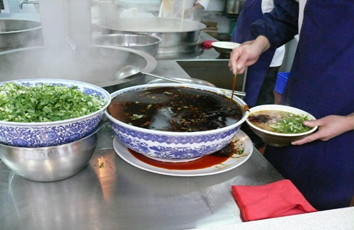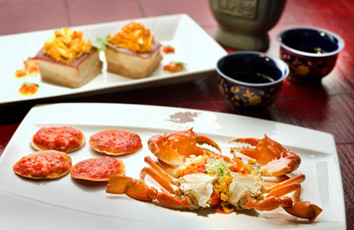在外地吃到家乡美食,容易种草还是踩雷?
看到家乡菜,人们十有八九会想试上一试。
无论是想解馋,还是想解乡愁,明知道可能会踩雷,却还是乖乖掏钱的异地游子们,通常会扫兴而归。
知乎有个典型的体验类问题:“在异地吃到不正宗的家乡菜是一种怎样的体验?”
该问题吸引了2296个答案。
每一个答案背后可能都是一张错付的嘴,一个被辜负的胃。
Lanzhou beef noodles
兰州牛肉面

Lanzhou beef noodles originated from Lanzhou, Gansu province in China. This dish was first created by the Hui people and its recipe has been passed on for generations. Today in Lanzhou alone there are more than 1,000 beef noodle restaurants, an affirmation to the popularity of the dish.
兰州牛肉面起源于中国甘肃省兰州市。 这道菜最初是由回族人发明的,其配方已由一代代人传承至今。 如今仅在兰州就已有1000多家牛肉面馆,这也反映了兰州牛肉面的受欢迎程度。
Stinky tofu
臭豆腐

Stinky tofu is a Chinese form of fermented tofu that has a strong odor. It is usually sold at night markets or roadside stands as a snack, or in lunch bars as a side dish, rather than in restaurants.
臭豆腐是中国发酵豆腐的一种,具有强烈的气味。 它通常在夜市或路边摊上作为小吃出售,或者在快餐店卖当小菜卖,一般餐馆里没有。
Stinky tofu is a symbol of Changsha street snack, and it is also called “chòu gānzï” by local people. Changsha stinky tofu is famous for its spicy flavor. Different from Sichuan stinky tofu, Changsha-style has black crackling.
臭豆腐是长沙街头小吃的象征,当地人也称其为“臭干子”。 长沙臭豆腐以其辛辣的风味而闻名, 与四川臭豆腐不同,长沙臭豆腐有黑色脆皮。
Cha chaan teng / Hong Kong-style cafés
茶餐厅

Cha chaan teng, often called Hong Kong-style cafés in English, is a type of restaurant originated in Hong Kong. Cha chaan teng locations are commonly found in Hong Kong, Macao, and parts of Guangdong.
茶餐厅是一种起源于香港的餐厅,通常也被称为港式餐馆。 在香港、澳门和广东的部分地区,都可以找到茶餐厅。
Due to the waves of mass migrations from Hong Kong in the 1980s, they were established in major Chinese communities in Western countries such as Australia, Canada, the United Kingdom, and the United States.
由于1980年代香港的大规模移民浪潮,澳大利亚、加拿大、英国和美国等西方国家的主要华人社区中也出现了许多茶餐厅。
除了上面提到的这些,其他特色食物也没有逃过“异地必雷”这个定律。
南京人在武汉吃金陵鸭血粉丝、天津人在美国吃煎饼果子、太原人在外地吃没醋味儿的过油肉……基本上你在地图上做连线题,每根线都能生产一个故事。
城市化进程和交通的便利让各地特色小吃都有了在异乡扎根的机会。但制作条件的限制、食材特殊的要求、家乡师傅的手艺、本地化的压力,任何一个因素都有可能让人在那2296个答案后面再加上一条。
在异地寻味故土,是比找对象还难的事情。但哪怕明知面前可能是雷,却还是愿意掏钱。为什么呢?
有外媒总结了两点原因:
1. Food preferences are deep and ingrained
食物喜好是根深蒂固的
Many flavors and spices are acquired tastes. If you are exposed to them as a child, you develop a preference for them over time. This doesn’t just apply to extremely specific tastes like, for example, Vegemite. It happens with spices as basic as salt or sugar.
很多味道都是习得的。如果你小时候就接触到了某些味道,那么慢慢你就会对这些味道产生偏好。也不是说只有强烈的特定味道(比方说维吉米特黑酱)才能产生偏好。像是基本的盐味和甜味也能有偏好记忆。
2. Food forms part of your identity
食物形成了你的身份认同
The desire for food from home goes deeper than just craving certain tastes. Food is an important piece by which we define culture, and therefore a piece of how we see ourselves as people. Think about how many holidays are tied to special meals, or how many family traditions are focused on foods or recipes.
对家乡食物的渴求往往并不仅仅停留在想吃某种特定的食物。食物的重要性在于,我们用它来定义文化,同样我们也借食物来观照自身。想想看,有多少节假日是和特定食物绑定在一起的,再者,有多少家庭传统是以食物或食谱为中心的。
大西洋月刊的文章认为,怀旧之情让人无法割舍故乡食物。
Nostalgia - a force that is as commonplace as it is amorphous and deeply personal - shapes people’s connections to the food they grew up eating.
怀旧思乡——这股力量十分普遍、毫无定形、又十分个人化——它塑造了人与从小吃的食物之间的关系。
People return to, and extol the virtues of, their hometown favorites partly because they’re stuck in a dance between their past and present selves, and because they subconsciously want to reaffirm the conclusions they came to as children. Childhood is really an important time in forming your own identity.
人们之所以回到家乡,赞扬家乡美食的好,是因为他们陷在了过去自我与现在自我之间,人们下意识地会想重新确认那些少时就做出过的判断。童年的重要在于它塑造了你个人的身份认同。
难怪有人说:不在异乡尝试故乡擅长的味道是对双方最大的敬意。
那些本地化了的“家乡菜”经不起你的非难,那个家乡的馆子也不忍你在外胡乱解馋。
想家了啊?回去吃吧。


